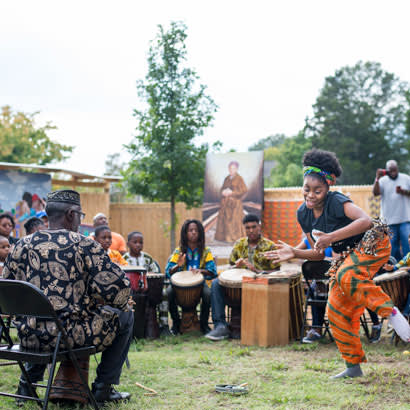
We know that place matters and can have long-term effects on the well-being and health of a person, shaping his or her life expectancy and social economic mobility. Travel anywhere in America and you can tell a lot about the social cohesion of a community based on its public spaces. Research shows that public spaces can foster greater tolerance, improve public health and strongly influence a person’s sense of social value and belonging. The intentionality of how you plan, design and measure for these outcomes is critical for building more inclusive and healthy places.
The Framework
The Robert Wood Johnson Foundation and Gehl Institute have partnered to develop a framework for considering inclusion and health in the design and programing of public spaces. The framework is a comprehensive guide that includes a set of measurable indicators centered around four central principles of inclusion and health equity within the context of public space. These principles focus on community context, the process that shapes public spaces, design and program, and how to sustain the dynamic and interconnected drivers that impact communities. The framework supports a working definition of inclusion as an outcome, a process and a tool for change.
The framework is built around four guiding principles for shaping and assessing public space projects. Only one principle addresses physical space, reflecting the need for practitioners to look beyond physical design and placemaking to create change.
- Principle 1: Context. Recognize community context by cultivating knowledge of the existing conditions, assets and lived experiences that relate to health equity.
- Principle 2: Process. Support inclusion in the processes that shape public space by promoting civic trust, participation and social cohesion.
- Principle 3: Design & Program. Design and program public space for health equity by improving quality, enhancing access and safety, and inviting diversity.
- Principle 4: Sustain. Foster social resilience and capacity of local communities to engage with changes in place over time by promoting representation, agency and stability.
We often experience public spaces based on our individual context of place. However, it’s essential to acknowledge that you can never truly be an expert of a home in which you’ve never lived. It’s easy to determine what’s wrong with a place but more important to understand what happened and recognize its community context. There is a deep history of exclusion in the design of places based on race and income that may have limited a community’s ability to thrive. Acknowledging the exclusionary aspects, respecting community assets and cultivating the connections shared through the lived experiences of a user (resident) sharpens one’s perspective in properly assessing a space. Context is central to building more inclusive, healthy places.
Shifting to People-Centered Planning
As we develop and redesign public spaces, we must grapple with past planning practices that limit access to shared spaces. An inclusive process can build social capital, improve public participation and promote civic trust, which can offer shared ownership and advocacy power for a project. Leaders should consider the process of building more shared spaces as an opportunity to celebrate the social resilience and cultural legacy of a community. As practitioners, it’s crucial we stop acting like we’ve discovered a space that people have lived in and near for generations. We must transform the way communities are designed by making the process for shared spaces an opportunity to thrive.
Let’s also focus on the people who currently live in these spaces, not just on those who may be coming, as we reinvest in places. The community stability and preparedness for change is an essential factor to consider. Leaders have a social responsibility to consider the impact of how an investment in a space can lead to displacement. Let’s shift to people-centered planning that creates the space to learn what’s important to the user and incorporate it in the design and program. Leave the renderings as the final stage in the process to understand the context, develop an inclusive process and determine what is required to improve the current condition of the community. This will require leadership from various sectors for partnering and advancing the common vision.
Since people and the spaces they experience are dynamic and interconnect, like the communities they represent, inclusion and health equity can be a moving target. The structural impact of racism remains embedded in so many aspects of public life that even the best-intentioned projects can be deemed exclusive. We must meet people where they are and commit to addressing the past in forward-looking ways. The framework is linear, but people are not, so being open to evolution is important. Practitioners must be adaptive and responsive to the changing needs of a community during the life cycle of a project, from conception and planning, through design and implementation, to achieve better outcomes.
Public spaces can support more equitable health outcomes so long as they are designed and sustained with both health and inclusion in mind. The design needs to start with people at the center. Collectively, we can develop inclusive shared spaces in our community that honor its cultural legacy and are welcoming to all, regardless of who you are, how much you make or where you reside.
Framework reference: Inclusive Healthy Places: A Guide to Inclusion & Health in Public Space: Learning Globally to Transform Locally by the Gehl Institute
Stephanie Gidigbi is the Director of Policy & Partnerships for the Natural Resources Defense Council (NRDC) Healthy People Thriving Communities Program and a member of the NRPA Equity Advisory Group.

